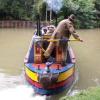Indeed not only worked for BWB, but also actually lived in the cottage you mention. This was Cow Roast lock
Don't forget the moleskin trousers!!
Well people are wrong if they really do make such sweeping statements
Some of it is river fed, but certainly not towards the start of the descent to London
If there was sufficiently an abundance of water that you didn't need to worry about leakage, then there would not have been locks on the descent through Berkhamsted to Hemel Hemptstead which had side ponds in a bid to minimize water use.
And yes, my association with the Grand Union goes far enough back to have regularly operated side ponds.
Other than the K&A which did eventually create some kind of paid for permit, (at least in the Devizes area), I think that elsewhere in the country they were free. We had them, but were never once asked to show them.



